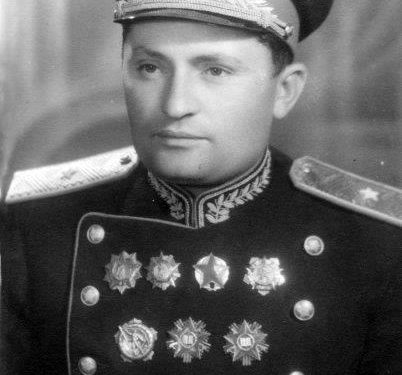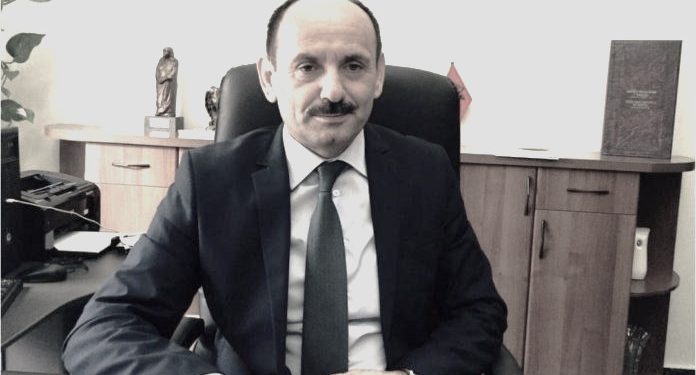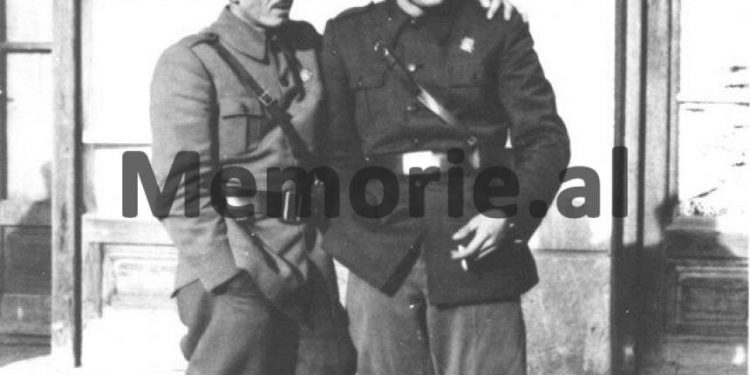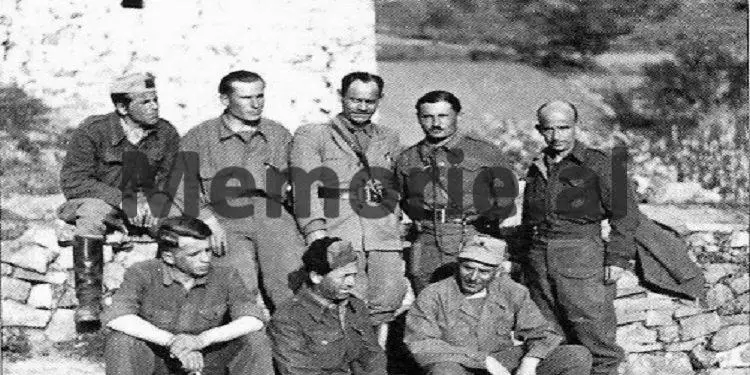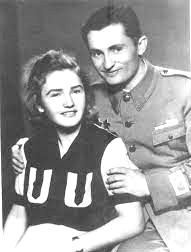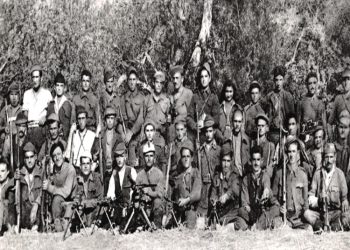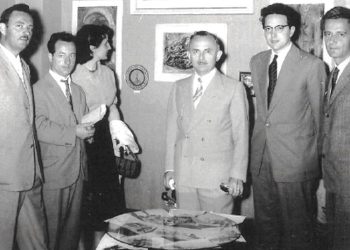Memorie.al / Gjetë Ndoj, the former General Director of the Central Archive of the Albanian State, and also for years part of the political structures, (as the head of a small party), at the same time a historian, researcher and well-known publicist, author of several historical books, among others, he has also written a book (monograph), dedicated to the well-known general from Mirdita, Gjin Marka Toma, one of the central figures of the Albanian Communist Party and the Anti-Fascist National Liberation War, who had a tragic fate, after spending long years of his sentence in Burel prison, where he died of a serious illness, in August 1986, after the President of the Presidium of the People’s Assembly at that time, Ramiz Alia (subordinate to Gjin Markut during the War), refused to release him by decree, so that he would die at home. For more about the figure of Gjin Mark, but also of his province, Mirdita, and also the history of Albania, we are familiar with the interview with Mr. Gjet Ndoj, which we are publishing below in this article.
Mr. Ndoj, what is your general opinion about Mirdita’s trip?
The region of Mirdita and the people of this region are truly a people that may be economically behind other countries. This has an explanation, according to the facts that I have conveyed in the book “Mirdita and the Catholics”. The Catholic areas around these three are the most special areas of Albanians in terms of efforts and struggle for the survival of the fundamental values of our nation. This is proven in history, it is proven when you study personalities, when you study the Catholic Clergy, especially the institution of the Catholic Church, which was an institution where the word of God was not simply said, but where the most basic values of the entire Albanian people were kept.
The Albanian language was preserved there, which is everyone’s value. Clerics also perform the mission of leading the people and their race, against the age-old enemy, against Turkey, against the invaders. This is related to a historical circumstance, because Turkey invaded Albania and hit the Albanian aristocracy. The largest families were the Kastriots, Dukagjins, etc. Which were compared to the noble families of Europe?
The invaders have tried to exterminate the aristocracy, as the leading part of the people, it was hit very hard, and whoever could escape, fled from Himara and to South Italy. Another part agreed to Islamize. Under these conditions, the aristocracy could not be the elite of the nation. And the clergy took this mission. The reason was that the clergy took over the leadership of their people.
How has the canon been understood by foreigners, or different scholars?
We Albanians must accept our truths, which do not embarrass us, but on the contrary we must see it realistically and have enough courage to tell the truth as it is. We are honorable before Europe, because if we will research a little to see the truth, we will simply distinguish that we are a European people. For this reason, we are rather being dragged down by Europe, rather than showing that we are European, continuing from the mentality, politics, and other academic institutions that depend on the state. We have a kind of canon, which is rare among other nations; it is a kind of spiritual and state constitution in the sense of the organization of these countries that you mentioned.
What do you think about this?
When the Ottoman Empire began to rot, a noble class began to reborn, three such as Mirdita, Miran Shuflaj, says: “Mirdita, Himara, Lunxëria, were the first cells of the state to form the Albanian state”, this is because they previously created the state or institutions resembling the state, which were guided by certain rules, such as the Canon.
We are one of the foundations of Europe, the Albanian language today is one of the testimonies, not just of the Albanians, but it is also an authentic European testimony, such as the Basques and the Celts. The Albanian language is the only surviving one in the world. Regarding the canon, today we live in the time of the modern state and the canon should not be compared with the state, but for the time it existed, there were extraordinary values of our survival.
What are those events and signs, which are the most important in typifying the Albanian?
An important fundamental value, apart from the Albanian language, I will emphasize the fact that we are entering into the research of our history, we see that we have a European history. The home of Albanian freedom, their leaven is preserved in the Catholic Church. We had a difficult rebirth, but we finally escaped, regardless of the footprints left by the invaders, footprints that do not coincide with European culture, despite this, we remained European. I say this because we kept those basic values that characterize our people.
We fanatically preserved the language, the tradition, the customs and we, after all, and our country geographically, is in Europe, we are in that position that we have contributed to Europe and it should support us for this fact. If I were a novelist, I would write an interesting novel, this fact is very inspiring. We Albanians should be proud and should not be at all inferior to Europe, as we have contributed more to them than they have to us.
How much are these events, these symbols worth in today’s times for the Albanian society?
Among the greatest assets of our cultural heritage are, of course, the symbols, which include heroes. Gjergj Kastriot Skënderbeu is accepted by everyone as a hero, due to the organization of the resistance, just as we have Mother Teresa, who has universal humane values and, fortunately for us, is part of our blood. These values give us a certain image and make us why not proud. Of course, these values affect our consciousness; remove the complexes that someone may have. Albanians are able to deal with science, to deal with culture, they are able to benefit from civilizations, and they have the ego and the courage to manage the economy and freedom.
Let’s move on to historical figures from Mirdita, Gjin Marku? What conclusion have you reached about this figure?
First, I would like to say something about his family background. Exactly, somewhere on the slope of Mount Skënderbeu, the mountain range that separates the territory of this well-known region of Kthella, with the Krujë-Tirana Highlands, there is Fushë-Molla, the birthplace of Gjin Mark. This village is rather a panoramic point, with a wonderful view. In 1927, Pjetër Marku was treacherously killed in the line of duty, leaving four orphaned children, two boys and two girls. The eldest was only nine years old and his name was Gjin.
Gjin Marku was born on June 2, 1918, in the village of Baz, in a well-known family in that province. When Gjini’s father, Pjeter Marku, dies, the latter’s friend, Hysen Selmani, as well as his butler Abaz Kupi, take 9-year-old Gjini and send him to Tirana, there to the “Vorfnore Shelter”. Here Gjini received his first elementary lessons and 5-year education. In 1932-1936, Gjin Marku graduated from the “Harry Fultz” Technical High School, in Tirana and later in Kavajë (only two months), Agriculture branch. After finishing school, he was appointed agronomist in the district of Korça.
What about his participation in the communist movement, when did it begin?
As soon as he was appointed in Korça, Gjin Marku came into contact with intellectuals from Korçë, and together with them he started the anti-fascist and communist activity (1936), within the Communist Group of Korçë, being one of the main leaders of this group., Via Koço Tashko , the brothers Gaqo and Pilo Peristeri, etc. Gjin Marku also knows Enver Hoxha, at that time a professor at the Korça High School.
Anti-fascist propaganda had started before Albania was invaded by Italy on April 7, 1939, since this (fascism) was a danger to humanity, many years ago (especially when Mussolini’s Party in Italy, and especially when Adolf’s National Socialist Party Hitler, had come to power in Germany. Gjin Marku, has been a very active participant since the beginning of the Anti-Fascist Movement, and this can be seen in his participation in demonstrations, and later in the formation of partisan units and squads.
In 1940, the Branch of the Korça Group was formed in Tirana, marking the expansion of the anti-fascist and communist activity of this group. Many people go underground, among them definitely Gjini. In the documents of the time, of the Royal Police Office and the Fascist Quaesture, some of the main ones, such as: Gjin Marku, Vasil Shanto, Mihal Duri, Gaqo Nasto, Niko Llagi, Ali Reçi, Ferit Xhajko, Kajo Karafili, etc., are shown to have been in pursuit by the bodies of the Fascist Power located in Albania, since April 7, 1939.
The anti-fascist activity of Gjin Mark, from 1941 onwards, has been intense and numerous. In addition to the testimonies, we also learn this in the documents of the time that we are analyzing, mainly in those documents, which are not only about his activity, but also the constant pursuit of him by the carabinieri and the fascist regime. On November 8, 1941, the Albanian Communist Party was formed, where Gjin Marku, one of its main founders, was elected one of the first seven members of the Provisional Central Committee of the Albanian Communist Party.
Gjin Marku played an important role in the organization of the communist movement in Peza. How does the truth stand?
After the establishment of the Albanian Communist Party, the Provisional Central Committee was elected, which had as its primary task the organization of the Party throughout the country, to play its role in the organization of the anti-fascist war. In this sense, the formation of the basic organizations of the NPSH was defined as a priority, especially near the territorial detachments that had begun to be created at this time. The premises to do such a thing, as we mentioned a little above, to form a party organization were created in Peza.
In addition, this organization had a special importance because Peza was an area suitable for being a very important base of anti-fascist activity, led by the Albanian Communist Party. That’s how it happened. The Provisional Central Committee tasked Gjin Marku to follow and lead this founding meeting in Peza, near its Ceta. 8 fighters of this gang participated in this meeting, such as: Vasil Shanto, Mihal Duri, Ferit Xhajko, Pandi Nashi, Baki Staria, Loni Grazhdani, Qazim Prishtina and Zoi Themeli, headed by the PKSH delegate, Gjin Marku.
How do fellow fighters of the Peza gang remember Gjin Marku?
The ex-fighter of this gang, Sali Verdha, remembers that he was amused when he saw his former school friend “Harri Fultz” Gjinin, as a delegate of the NPSH in Peza. Yellow indicates that; the meeting continued debates and work for two days. In the beginning, the proposal for secretary of the organization was proposed to Vasil Shanto. This proposal was rejected by Gjini, clarifying that Vasili was bigger than the secretary of the organization, as he was the Commissar of this Squad.
After this intervention, Mihal Duri was proposed as Secretary and was unanimously approved by the participants; Pandi Nashi was elected deputy secretary. Later, this organization grew rapidly, while Commander Myslim Peza became the only communist of this gang, after the liberation. This is how the first organization of the NPSH was formed in Albania, and fate or something else wanted it to be Gjin Marku, representative of the Provisional Central Committee of the NPSH.
How did the experience of Peza serve Gjin Marku, to throw him into the war?
After the transformation of the Peza Squad into a partisan squad, it turned into a very important base of the National Liberation War. For this, Sali Verdha remembers: “I also became a communist after two months. All the main leaders of the NPSH, not only came to Peza to give orientations and make plans, but here in Peza, they also came to learn the military art, Gjini knew all the fighters of the Peza detachment, the Commander Myslim Peza, but his closest friend was Mihal Durin”.
Gjini also has a wide activity in Berat District. Can you tell us something about that?
In December 1941, he was assigned the task of setting up anti-fascist guerilla units and clearly directing the anti-fascist activity of the squads for the liberation of the homeland. This organizational activity of the anti-fascist insurgent war of Gjin Mark initially includes the territories of Lushnja, Fier, Mallakastra, Berat and, up to Skrapar and beyond. When he came to Berat, Gjini first met Kristo Isak and two teachers from Skrapari; Nuro Dobrusha and Tajar Grepcka. The meeting with them was important because through them, Gjin Marku became familiar with the situation and quickly oriented himself in it.
They recognized Gjin Marku from the beginning, with Mestan Ujanik’s squad, a territorial squad of outlaws, until the beginning of 1942. From the first conversation, which talked about the transformation of the squad from a territorial squad into a squad with an anti-fascist program, commander Mestani, looked at Gjin Marku with great sympathy, for the anti-fascist and patriotic spirit he manifested and especially because of a very interesting way of communication, which the official from the Center had. With the new form that the detachment took, with a flag in hand they walked in many villages of Skrapar.
During these movements, Gjin Marku conveyed anti-fascist and patriotic messages, while the way of communication attracted the attention and sympathy of that brave and generous people. Skënder Malindi, about this very strange connection of Gjini, with the people of Skrapar, says: “This, among other things, happened; even though it was two years ago; Skrapari and Mirdita are similar in many things, customs and traditions to each other. For a very short time, Gjini gained immense popularity and in this sense, his word was law”.
This authority and the willingness of that people to respond to Gjin Mark’s anti-fascist calls and instructions, the organization of anti-fascist combat units, etc., were already a concern, not only for the commandos and fascist military units in Çorovoda and Berat, but a serious concern , for the Italian fascist authorities, up to Tirana. The organizing activity, with the anti-fascist spirit and character of Gjin Mark, extended not only to the Berat District, (which included the area from Skrapari to Lushnjë-Fier-Mallakastër), but also outside it, such as: in Vlorë, Tirana, etc. The documents of that time also prove this activity.
How were Gjin Mark’s relations with the “National Front”?
In 1942, Skrapari became the place where the “Ballistic Movement” was born and inspired. The inspirers of this movement were Skraparllinj intellectuals, such as: Abaz Ermenji, Muharrem Kapllani, etc. Although the Skraparlli – says Skënder Malindi -, they could never have the influence of Gjin Mark. Perhaps this is also due to the fact that “Balli” was created, when the mission that the Skraparlli had with Gjin Marku, for the freedom of the country in the fight against fascism, had started and it was impossible to remain halfway. On the other hand, as affirmed by contemporaries who are veterans of the War, it turns out that one of Gjin Mark’s great merits is that; He never used his power to burn and kills his ballistic opponents, etc.
This was precisely his strongest point, what made him the most influential man, not only in Skrapar, but also in Berat, Përmet, Mallakastër, Fier, Lushnje, etc. In the spring of 1943, the leaders Ballistas, Abaz Ermenji and Muharrem Kapllani, proposed to Gjin, the organization of a joint action (“Ballisto-Partizan”), for the liberation of Berat. It was agreed, but at the moment when the ballisticians insisted that there would be three ballisticians and only one partisan in the headquarters of this operation, Gjin Marku rejected this project, which remained only on paper.
The main reason was related to the fact that the ratio of forces was completely different on the ground, incomparably and in favor of the partisan forces, led by Gjini. In the same way, the objection was also related to the other fact, that in case of victory, “Balli” wanted to benefit at the expense of the partisan forces, the credibility of the “War” leadership, when they had few forces on the ground. However, the ballisticians tried to start an action, which failed, almost without starting.
And as a reward for all these energies, ideals and dedication that he devoted to communism, Gjin Marku was “rewarded” with death, in absentia. How did it happen?
After the liberation, Gjin was given several decorations and ranks, but being treated less than some others, that in terms of their contribution to the War, they were far away from Gjin Mark. The People’s Assembly, in the first years after liberation, decorated him with the Order “Medal of Remembrance”, with the other Order “Medal of Liberation”, etc., but never with the “Hero of the People” medal, which some leaders received of the National Liberation War. Until 1948, Gjini had continued the Superior Academy “Voroshollov” in Moscow and at the same time was the military attache, near our Embassy in the Soviet Union. With the debates that Gjini made at the First Congress of the SNP, with Enver, he was no longer allowed to continue in Moscow.
In 1949, when the ranks were given, with the rank of general, several were promoted, including Gjini. After the 1st Congress of the SNP (which took the name of the Labor Party of Albania, the APS), the main posts of the Communist Government were given. The appointment of General Gjin Mark, in the position of Artillery Commander, in 1948 and in the years 1951-1953, Commander of the United School, clearly expressed the tendency to gradually displace the former leader and the famous former war commander. Further, time helps us to see this trend more clearly.
In 1953-1955, Gjin Marku was appointed Commander of the Military Corps of Elbasan. In 1955, he returned from Elbasan to Tirana, to be appointed to the position of Commander of the Local Anti-Air Command, a position which Gjini held until 1961. At first, this Command, which was subordinate to the Ministry of the Interior and continued for another two months, when Gjini went here. Later this Command became part of the Ministry of Defense. During this period, Gjini had an office outside the Ministry building, somewhere near the former “International” Hotel, a very simple office without any great importance.
In July 1961, Gjin Marku was also dismissed from this position, to be appointed Director of the Llakatund Farm, in the Vlora district, where he worked until April 1963. The biggest problem that Enveri had for Gjin Marku , it has always been the fact that it was very difficult to formulate an accusation against him. Gjini was so well-known as a patriot and a communist at the same time, which made it a problem to convict him.
However, structures were created by the former State Security, not only to monitor him step by step, but also to denigrate him, through slanders, stagings and endless combinations, getting into his family life. The punishment of Gjini seemed to be a task that had to be carried out at all costs, and so it happened.
And, as if these were not enough, the imprisonment of Gjin Marku was also necessary…?!
Yes. Exactly. In this difficult situation, in April 1963, Gjin Marku was interned in Zvrnec in Vlora, an internment that lasted until 1967. At this time, his wife Natali Marku, along with their four children, were separated from Gjini, interned in the Swamp of Hoxhara, in Fier. Thus, the internment of Zvrnec was not an internment, but a real prison. Here Gjini met, among others, some comrades from the War, who suffered the same thing, such as: Kasem Trebeshina, Pëllumb Dishnica, (whom Gjini appreciated for his stay here as very dignified), Maqo Çomon, Xhavit The bag, etc.
Only after 4 years of efforts by the State Security, it was possible to assemble an accusation against Gjin Marku, that of “Agitation-Propaganda”, against the People’s Power Party, sentencing him to 10 years in prison. Thus, Gjin Marku was sentenced for the third time by the Enverist Dictatorship. In 1986, Gjini suffered from an incurable disease. He had another year, according to the account, to suffer in prison.
In the medical report, it was clearly stated that his illness was incurable. On this basis, Gjini’s family made a request-prayer, to get him out of prison early, in order to at least die at home. This request did not receive a positive response. After the disease weighed heavily on him, in May 1986, Gjin was sent to the prison hospital in Tirana, where he died on August 6, 1986. Perhaps this was the only salvation for Gjin Mark.
What about any special details from the life of Gjin Mark, or his family?
In 1945, they met and Gjini became engaged to Natali. In 1947, the marriage took place and God blessed this wonderful couple with four children, two daughters and two sons, namely: Svetlana (October 31, 1948), Aleksandrin (in 1950), then came Rita in 1952 and the last was born Kastrioti, in 1954. Since 1963, when Gjini is interned in Zvërnec, his wife Natali and all four children are interned in Fier, in Hoxhare, separating them from their father forever.
They also begin an ordeal of suffering that has no end. Of course, from the beginning they suffer, although they learn the reason for the persecution later, when they grow up. Pain, longing for their father, discrimination in society, systematic persecution by the State Security, economic poverty, loss of the right to education, etc., is some of the components of this tragic pain. Not only that, but one of the sons, Aleksandri, also spent five years in political prison, just because his father was an “enemy of the people”. After 1990, Aleksandri appears lost and his exact fate is still unknown, neither by the family nor by the official state institutions…! Memorie.al




